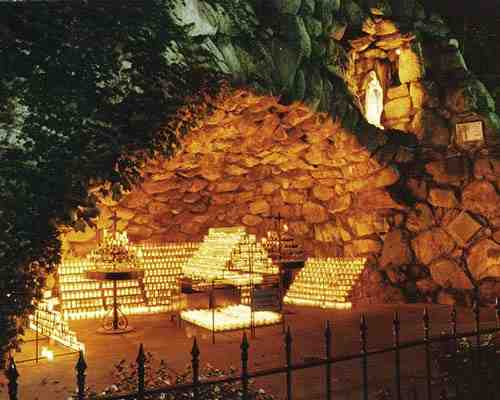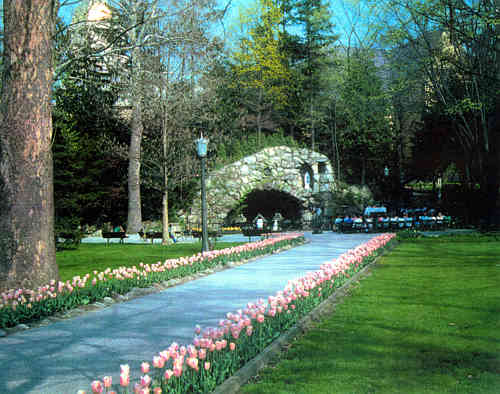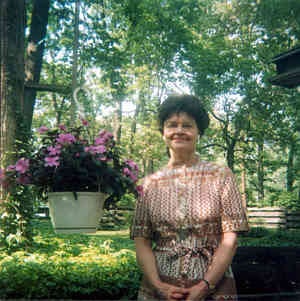
The Story Behind the Notre Dame
Grotto
By Dorothy V. Corson

Including other Notre Dame and Saint Mary's Mysteries
The Missing Empress Eugenie Crown
The Legend of the Sycamore Tree
St. Angela's Island
Available in two forms
A first-person journal of research
in the chronological order of my own investigation.
A shorter third-person account
in the chronological order of historical events.
To My Husband and Son
Jack and Greg
Always My Inspiration
And most especially
To anyone
who has visited the Notre Dame Grotto
and wondered, as I have,
who planned it, who built it, and how it came to be.

Note to the Reader
"A Cave of Candles: The Story Behind the Notre Dame Grotto" began
as a personal journal of my research of the history of the Notre Dame
Grotto. A copy of this updated manuscript was destined for a storage
box in the University Archives upon its completion last fall. However,
a curious set of circumstances, at the eleventh hour, has given it a
life of its own, in a way I would never have expected, on the Internet.
How it arrived there is a story worth sharing.
It has been said that "everything in life that matters is a mystery."
I have pondered those words many times since the first time I heard
them. As I've pondered the mystery of the paths my research has taken
since I first set foot on that "Trail of Memories" in the autumn of
1991.
My first-person journal of research was completed in the summer of
1994, two years before the Grotto's 1996 centenary. A retired priest
friend, Fr. George Schidel, C.S.C., who had been following my research
discoveries with great interest, was the first person to read my
preliminary manuscript. He asked my permission to share its new-found
history with Fr. Theodore Hesburgh, C.S.C. Father Ted, in turn, sent
me a beautiful letter of encouragement and directed me to those
officials on campus who might be interested in its historical research
for the Grotto's approaching centenary. They suggested I make a
condensed version of my manuscript in third person focused on Our Lady
and the Grotto's influence on the campus, which I completed on August
5, 1995. Six months later, they produced a beautiful illustrated
pamphlet containing an essay by James Murphy based on the research in
this second condensed manuscript. It was printed by the University for
the Lourdes Day celebration at the Basilica of the Sacred Heart on
February 11, 1996.
Shortly, thereafter, I was compiling a series of oral Grotto stories
I had randomly collected during my search to include as an appendix to
my journal of research. In the midst of rereading them, it suddenly
dawned on me that the quiet memories being made every day at the Grotto
were its true history and the most important part of my research yet to
be completed -- preserving, in their own words, the personal
experiences visitors to the Grotto took away with them.
The Grotto's August 5, 1996, centennial was six months away. I decided
to present my idea to Fr. Hesburgh to see what he thought of placing a
request for Grotto stories in the ALUMNI Newsletter which would have
the potential of reaching many of the 100,000 alumni who received it.
All the Grotto stories received would then be preserved, along with my
manuscripts, as an archival record of the history of the Grotto for the
next 100 years and beyond. Father Ted's response was just the boost I
needed: "You'll never know if you don't try. It's a great idea. Tell
them I sent you."
When the Grotto stories began arriving, they were all priceless. Too
precious to be hidden away in a box in the archives, unshared. What to
do? I knew publishing them myself was beyond my capabilities. This
time I went to Our Lady at the Grotto for inspiration. "Lady dressed
in Light , show me the way" was my heartfelt prayer. Immediately, an
analogy came to mind, I could abort the whole idea of publishing them
or give the idea up for adoption to give them the life they deserved.
The choice was obvious. With the permission of the powers that be at
Notre Dame, Mary Pat Dowling, who wrote the Grotto Stories Request for the ALUMNI
Newsletter -- and is now its editor -- compiled and published the research,
photographs and Grotto letters I passed on to her and gave birth to a
beautiful little book which she named, Grotto Stories: From the
Heart of Notre Dame, a book that would never have had a life
without her. Thanks to Mary Pat, and the help of her Notre Dame
Publications book designer, Marty Schalm, miraculously, it was ready in
time to commemorate the 1996 Centenary of the Grotto and is now in its
second printing. If ever there was a miracle associated with the
Grotto, it has been seeing that beautiful little book in print for
future generations to enjoy.
Now all I had left to do was make a new master copy of my 360 page
journal of research, which I had been continuously updating, and get a
Kinko copy made of it to go with my condensed manuscript already stored
in the archives. My one regret: only a fraction of the research in my
manuscript had made its way out into the world.
Unbeknown to me, Our Lady wasn't finished with me yet. To my surprise,
Wm. Kevin Cawley, Curator of Manuscripts at the archives, very kindly
offered to make the master copy for me on their letter-quality printer.
When I returned to the archives a couple days later, he handed it to me
and asked a totally unexpected question. In the process of checking
the printouts he said he began to read my manuscript, thought it had a
"voice," and asked my permission to publish both manuscripts on the
Internet. Be careful what you wish for . . . .
As the saying goes, "Never Underestimate the power of a woman,"
especially the Lady in Blue. Wm. Kevin Cawley, the Curator of
Manuscripts she had planted in my path, was also the Web Master of the
University Archives. Fr. Hesburgh's comment on our first visit, "The
help will be there when the time comes," had foretold the future.
Our Lady never lets a deed done in her honor go unrewarded. My
research at Notre Dame has been blessed by "earth angels" seen and
unseen. May Heaven bless all the good people who have been
instrumental in helping me tell Our Lady's Notre Dame story to the
world.

Dorothy V. Corson
Lourdes Day
2000
First, I would like to acknowledge Thomas Schlereth's part in this
story. Had it not been for a casual comment he made to me, a stranger,
over the phone, this story would not have been written. I had been
given his name as someone to contact who was steeped in Notre Dame
history. I knew he had written The Dome of Learning: The University
of Notre Dame's Main Building and The Spire of Faith: The University
of Notre Dame's Sacred Heart Church and was hoping he might be writing
a third, on the history of the Grotto. With the title, A Cave of
Candles: The University of Notre Dame's Grotto, perhaps? When I asked
him if he was going to write another book, similar to the other two,
for the Grotto's 100th Anniversary, he said: "No I don't plan to. Why
don't you?" It was the inspiration of his unexpected comment, and the
realization that probably no one else was going to do it, if I didn't,
that prompted my first visit to the University Archives where most of
my research on the Grotto was centered.
I would like to acknowledge the continual help, during the past
eight years, of everyone at the University of Notre Dame Archives.
Most especially, Peter Lysy, for his cooperation, patience and kindness
toward a novice from the first day of my search. Without his guidance
and friendly suggestions, I would not have had the courage to get past
square one. To Sharon Sumpter, always there, in her calm quiet way, to
assist in locating files and explain finding aids. To Wendy Schlereth,
whose keen memory and helpful suggestions planted me on many an
interesting side path. To Charles Lamb who scanned many of the
photographs that enhance the text. To Bernadette Terry, Matthew
Steffens, Delores Fain, Nancy Hanson, Marlene Wasikowski, Angie Kindig,
Walter Ray, Erik Dix, and Matt Wilken, all helpful members of an
excellent team effort to make researchers feel welcome. And to Kevin
Cawley, Web Designer and computer guru -- who weaved it all together --
my heartfelt appreciation. This story would not exist on the Internet
without him.
Also a special thanks to the following: To Rita Erskine at Rare
Books and Special Collections, who welcomed me with a special warmth on
my first day there, when I felt like a fish out of water, and who has
become a very special campus friend. To Bob Ringel, architect, artist,
and photogapher, who generously shared many of his beautiful
photographs of the campus to illustrate this trail of memories.
For more of his campus photographs, see the
Notre Dame Photo
Gallery.
And to Linda Dunn, for sharing her serene green Grotto photograph in
Chapter 1. For me, it will always be, the 1996 Commemorative Centennial
photograph of the Grotto. To Rev.
James T. Connelly, C.S.C., and Jacqueline Dougherty at the Indiana
Province Archives Center, where my search began, who encouraged me to
visit the University Archives. To the Sisters of the Holy Cross for
their kind cooperation, and to my Sister friends at Saint Mary's
Convent, Sister Bertha, Sister Faith and Sister Miriam Kathryn; and to
Sister Rosaleen, Saint Mary's College Archivist, and Sister Monica, who
were always there to lend an ear and followed my progress with
interest. And especially, to Bob Hohl, Reference Librarian at
Cushwa-Leighton Library, Saint Mary's College, for his continual encouragement
from the beginning. He always went out of his way to offer suggestions
and make me feel welcome.
To Father Schidel, who came along when I needed someone just like him,
who was one of my strongest encouragers. He was the first one to
critique my manuscript, and did so with infinite care, offering
unfailing interest and constructive suggestions along the way.
To Sue Dietl, Head of Access Services at the Hesburgh Library, who
arranged a complimentary library card, opening a world of new books to
take home that I would never have had the time to read at the library.
And to all the unsung Reference Librarians at Hesburgh Library who, like
Carol Szambelan, exemplify the kind of help that a reference librarian
is always there to provide.
To Mary Waterson and John Palmer in the History Room, and Brenda
Loving in Interlibrary Loan at the St. Joseph County Public Library,
where I was always warmly welcomed. To Jackson Armstrong Ingram,
Archivist, St. Joseph County, who introduced me to those musty old
coroner's ledgers. To Terry Frost, whose suggestions, early on, put my
computer back in service when the power board went out and it was
sorely needed. Without it this story would never have been attempted.
And last but not least, to Rev. Theodore Hesburgh, C.S.C., Dr. Ralph
McInerny, creator of the Father Dowling mysteries, Rev. Richard
Warner, C.S.C., Richard Conklin, James Murphy, and Ann Korb who
generously offered to read my finished manuscript and offer their
opinions.
There is just not enough space to thank everyone, from day one, who
helped along the way; but Victor Couch, Mary Grix and Mary Kintz
exemplified the many people I contacted who responded with interest and
friendliness.
To one and all -- those I've mentioned and so many others along the way
who offered their encouragement -- I would like them to know that I
appreciated each and every piece contributed to the Grotto Puzzle.
Bless all of you for helping to make this story possible.
Dorothy V. Corson
* * * * *
A special acknowledgment to all those writers
of the past 150 years of campus history
who penned the many descriptive passages
excerpted from their writings which became
a major part of the text of this story.
D. V. C.
Web design by Kevin Cawley
© Copyright 2001 by Dorothy V. Corson.
All rights reserved.
<< back |
Cave of Candles
| next >>



